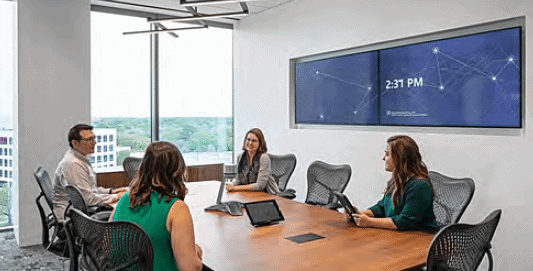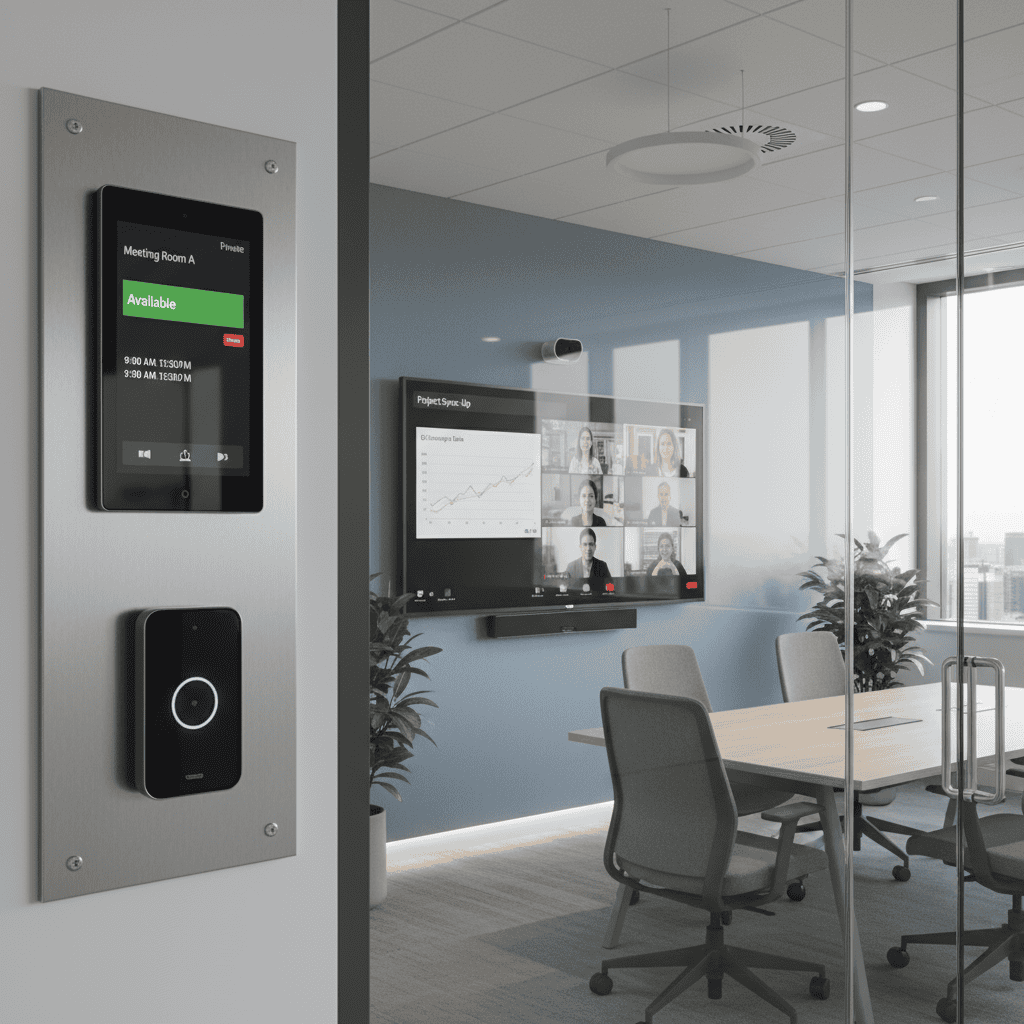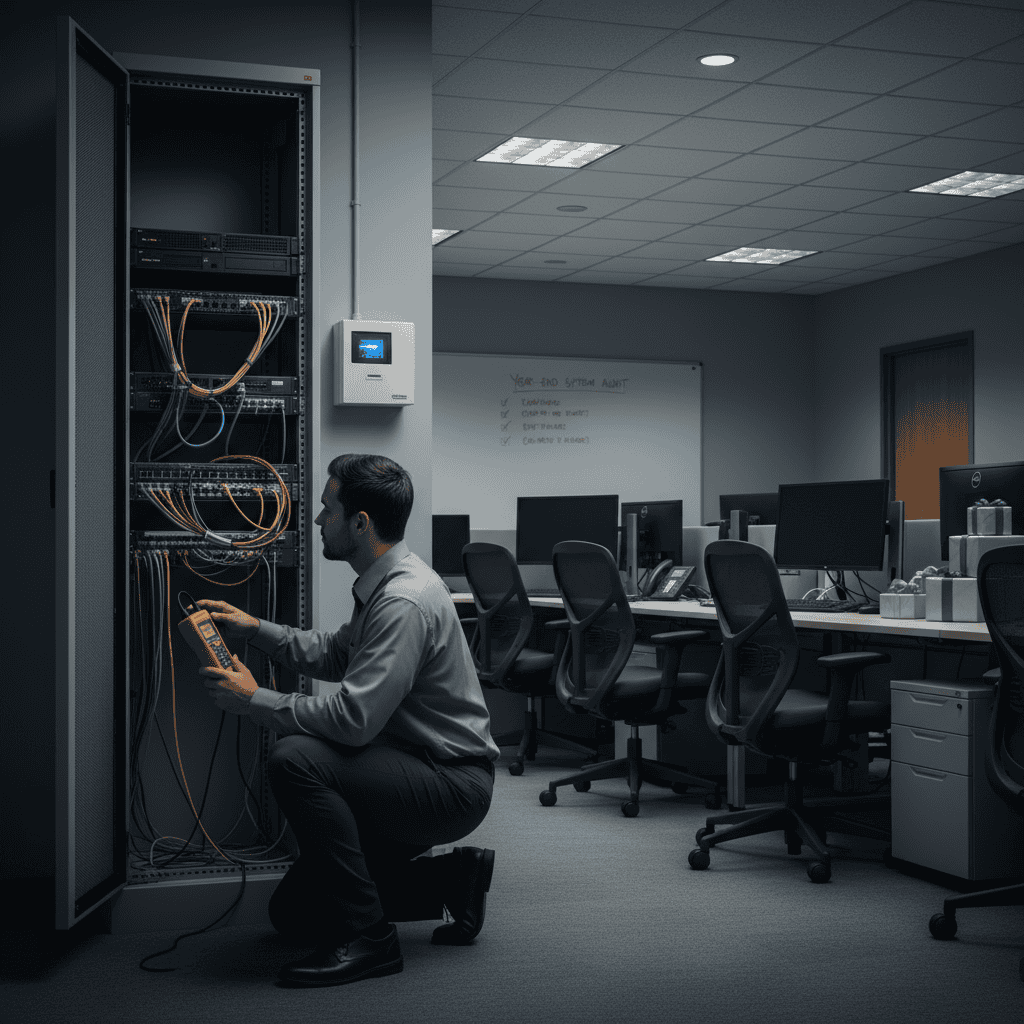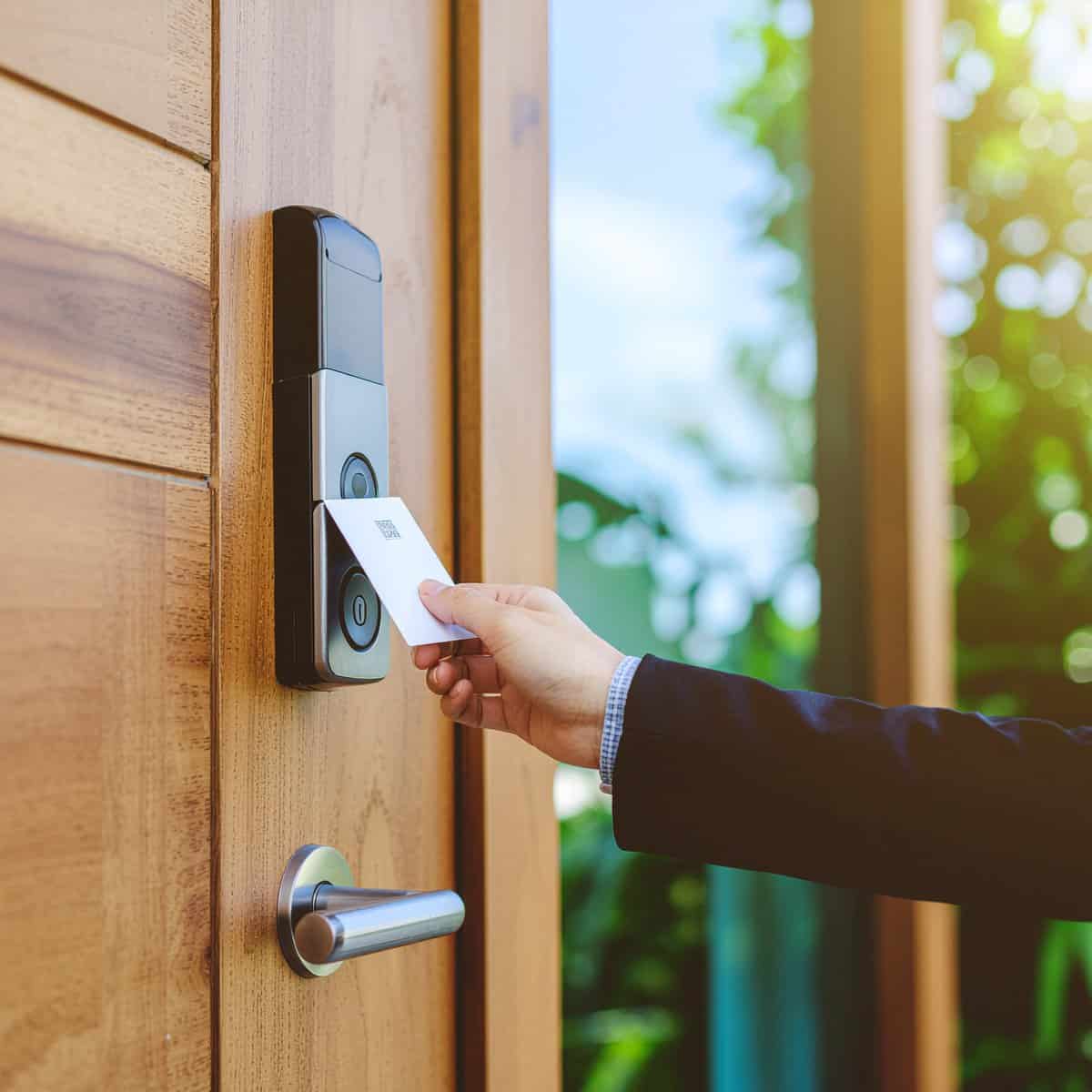Elevate Your Workspace: Audio Visual Upgrades for a Modern Office

When it comes to running a modern, productive office, you need the right tools and resources. Your staff and clients need functional spaces in order to stay organized and keep up with their tasks. But it’s not enough just to have updated technology – audio-visual upgrades are essential for any workspace to reach its full potential. Don’t settle for ancient projectors or outdated televisions when innovative options like interactive whiteboards can help unite employees and offer clients more engaging presentations. In this blog post, we’ll dive into how investing in quality audio-visual upgrades can elevate your workspace so your team has what they need to power through tasks quickly and efficiently.
Determining If It Is Time To Upgrade Your Conference Room AV
Evaluating the need for an audio-visual system upgrade in a corporate office is crucial to ensure optimal productivity and seamless communication. The first step in this evaluation process is to gather feedback from the people who use the technology regularly. Conducting surveys or holding discussions with employees, team leaders, and other stakeholders can help identify pain points and areas for improvement. Common feedback might include issues with audio clarity during video conferences, difficulties in connecting devices, or outdated display quality. Understanding the user experience is essential in tailoring the upgrade to meet the specific needs of the workforce.
Another aspect to consider is identifying outdated systems or components within the existing AV infrastructure. Technological advancements occur rapidly in the AV industry, and older components may not be able to keep up with modern demands. For example, legacy projectors might lack high-definition resolution or may not support the latest video conferencing software. Similarly, outdated cabling and connectivity standards may lead to signal degradation and unstable performance. Alternatively, you might discover that employees frequently request various connectors or resort to carrying a bag of dongles.
Several common challenges are faced with outdated AV systems, which further emphasize the need for upgrades. One prevalent issue is poor audio and video quality during meetings and presentations. This can lead to frustration, loss of engagement, and reduced effectiveness of communication. Additionally, outdated AV systems might lack compatibility with newer devices, making it challenging for employees to connect their laptops, smartphones, or tablets seamlessly. The absence of modern collaboration features, such as interactive whiteboards or wireless screen sharing, can hinder creativity and impede efficient teamwork. Furthermore, maintenance and support for older AV components can become increasingly difficult and costly as spare parts become scarce, impacting system reliability and uptime.
Setting Upgrade Goals For Your Upgrade Initiative
When considering upgrading audio-video equipment in an office, setting clear and strategic goals is essential to ensure a successful and effective transformation. The following goals should be considered to make the most out of the AV upgrade:
- Creating Collaborative Spaces: AV upgrades should prioritize fostering employee collaboration. This involves implementing modern technologies, such as interactive whiteboards, and wireless presentation tools. These upgrades enable seamless brainstorming, interactive meetings, and real-time remote collaboration. By creating collaborative spaces, the office becomes a hub for creativity, innovation, teamwork, and knowledge sharing.
- Enhancing Communication: Clear and efficient communication is vital to any successful organization. Prioritize audio-video equipment that enhances communication channels, such as high-quality audio systems, noise-canceling microphones, and advanced video conferencing solutions. These tools facilitate smooth and productive interactions, improving efficiency and effectiveness in daily operations.
- Simplifying AV equipment maintenance is a crucial goal. Using wireless technology reduces cable clutter and improves system management. Wireless connectivity allows for flexible reconfiguration of meeting spaces, adapting quickly to changing requirements. Centralized AV control systems streamline maintenance, making it efficient for IT teams to address issues promptly.
- Enabling Remote Employees: In today’s dynamic work environment, remote work is increasingly common. Upgrading AV equipment with remote-friendly solutions empowers remote workers to fully participate in meetings, collaborate with colleagues in the office, and contribute to projects as if they were there in person. Investing in high-quality video conferencing equipment, seamless screen sharing, and reliable internet connections ensures remote team members feel engaged, valued, and connected with their in-office counterparts.
Setting goals for audio-video equipment upgrades empowers businesses to create a modern, collaborative, and productive work environment. Embracing the latest AV technologies benefits employees and positions organizations for growth in an evolving business landscape. As an IT consultant, I recommend assessing office needs and aligning AV upgrades with strategic objectives to maximize ROI and drive long-term success.
Top Audio Visual Equipment Upgrades For The Office
Projectors
Projectors offer an excellent solution to elevate any meeting room. With the ability to showcase images and videos on a larger screen, they ensure seamless visibility for all participants. Modern projectors come in various sizes and brightness levels, allowing you to find the perfect fit for your requirements. Moreover, many projectors now feature wireless connectivity, enabling convenient laptop or device connections without the hassle of wires.
Video Conferencing Systems
Video conferencing systems offer users the ability to connect with remote participants through video calls, eliminating the need for extensive travel or costly expenses. These feature-rich systems provide high-definition video quality, diverse camera angles, recording functionality, and collaborative whiteboarding capabilities. They are ideal for businesses seeking efficient and convenient virtual meetings with participants from around the globe, all while remaining in the comfort of their own offices. Additionally, they are a critical communication and collaboration tool if you have a portion of your workforce working from home.
Interactive Whiteboards
An Interactive whiteboard offers a user-friendly interface that enables drawing diagrams or jotting down notes directly on the screen using either fingers or digital pens (depending on the type chosen). This eliminates the need for manual note-taking on traditional paper boards, saving time and enhancing the overall experience for all attendees at meetings or presentations. By synchronously following the content being written or drawn on the board, everyone can effortlessly stay engaged and informed.
Automated Room Scheduling Software
Automated room scheduling software efficiently streamlines the process of booking rooms. It enables users to easily check room availability online and offers useful features like automated reminders as bookings near expiration dates. This ensures that double bookings are avoided and keeps everyone informed about upcoming events in a specific area. By eliminating manual labor, this software greatly enhances the booking process.
Acoustic Treatment
Optimizing sound quality in meeting spaces is crucial for effective communication. Acoustic treatment solutions, such as panels and sound-dampening materials, reduce reverberation, ensuring clear and intelligible conversations by minimizing background noise interference. These solutions are particularly beneficial in larger spaces, preventing voices from getting lost amidst the cacophony of sounds. To enhance privacy in conference rooms, Sound Masking Systems can be deployed effectively.
Automated Window Treatments
Automated window treatments are gaining popularity in modern meeting rooms. They effectively block unwanted glare from natural light while allowing in a pleasant amount of natural light. Equipped with sensors, these treatments automatically adjust based on external sunlight levels. Users can focus on their presentation or conversation without the hassle of manual adjustments. There is the added benefit that window treatments can help keep your office cooler, reducing heat gain by 77%.
Control Systems
Control systems provide users with the convenience of managing multiple devices in a meeting space using just one remote control or app interface. This is especially beneficial for busy professionals who value efficiency and want to eliminate the hassle of dealing with multiple pieces of equipment during meetings or presentations. With a reliable control system, users can effortlessly transition between devices like projectors and HD displays, without the need for manual adjustments every time they require changes or updates in the space.
Video Conferencing Systems
Forty percent of employees spend between four and twelve hours in video conferencing every week. These systems enable real-time communication over the internet, bridging the gap between people located in various locations. As a result, it has become imperative for modern meeting rooms to embrace this technology to enable conference calls, team meetings, and brainstorming sessions with distributed workforces.
Audio Systems
A well-chosen audio system can significantly elevate presentations and foster active participation in meetings. By investing in a premium sound system, you guarantee clear and distortion-free communication, allowing every participant in the room to hear with utmost clarity. For an even more immersive experience, consider strategically placing multiple speakers throughout the space.
High-Definition Displays
High-definition displays are indispensable for meeting rooms seeking to leave a lasting with employees and clients. With their superior image quality, HD displays ensure effortless reading of text and enhanced viewing of images on the screen. Moreover, these digital displays offer the flexibility to stream audio and video content from various sources, including computers and streaming services. Given that they can come in a variety of sizes, the make a perfect visual addition to small conference spaces like huddle rooms.
AV System Security Considerations
With AV systems, upgrading is crucial for security. Sensitive conversations, whether in the boardroom or with clients, require safe and robust systems. As AV technology becomes more interconnected, security measures are essential. Here are key considerations for IT professionals:
- Network Segmentation: AV systems are commonly connected to the corporate network for communication and remote access. However, this integration may expose them to cyber threats. Implementing network segmentation, and isolating AV systems on separate networks, reduces the risk of unauthorized access. Even if one segment is compromised, the rest of the network remains protected.
- Secure Remote Access: Modern AV systems provide remote access for administrators to manage and monitor equipment from anywhere. To ensure security, IT professionals should enforce strict authentication measures like multi-factor authentication (MFA) and strong passwords. Using Virtual Private Networks (VPNs) adds an extra layer of encryption and security when accessing AV systems remotely.
- Firmware and Software Updates: Keeping AV equipment’s firmware and software up-to-date is essential for security. Manufacturers regularly release updates to address vulnerabilities and improve system performance. IT professionals should have a proper schedule for checking and installing updates, ensuring that all AV components are running the latest secure versions.
- Physical Security: AV equipment is susceptible to tampering or theft, especially in open offices or public areas. IT professionals should secure devices with lockable cabinets, surveillance cameras, and limited access for authorized personnel.
- Encryption and Data Protection: AV systems handle sensitive information, like video conference recordings. Using encryption protocols ensures secure transmission of data between devices and servers, preventing interception by malicious actors. Implementing data protection policies controls access and prevents unauthorized sharing or distribution.
- User Training and Awareness: Despite robust security measures, human error remains a major cause of security breaches. The best way to keep people safe is to regularly train employees on AV system security best practices. This includes teaching them how to recognize phishing attempts, avoid suspicious links, and handle data securely.
Setting An AV Equipment Budget
Setting a budget for office audio-video equipment upgrades is crucial for a cost-effective transformation. Follow these steps:
- Assess current AV infrastructure.
- Define project goals and requirements.
- Research AV technology options.
- Get multiple quotes from vendors.
- Allocate funds for support and maintenance.
- Plan for future scalability.
- Include training costs.
As a rough guide, you should expect to spend the following:
Huddle Rooms: $4,000 to $15,000
Small Conference Rooms: $10,000 to $25,000
Large Conference Rooms: $25,000 to $60,000
Boardrooms: $50,000 to $100,000
Need Help Upgrading Your Office?
Upgrading your office audio-visual equipment is not only necessary for staying competitive in the marketplace, but also to keep employees happy and engaged. Having an effective AV system that works well will help promote productivity, improving overall office morale. With these improvements, you can create a better workplace to ensure company success in the years ahead. Be sure to research what solutions will best meet your needs, while also factoring in budget considerations. Every business should have reliable audio-video equipment that helps you remain productive during important meetings and day-to-day operations. Need help upgrading your audio-visual technology or designing your meeting room? Let i.e. Smart Systems assist with their extensive line of services for transforming any workspace into a high-tech hub designed for success. Contact i.e. Smart Systems today to get started on giving your office the upgrade it deserves!
About i.e.Smart Systems
i.e.Smart Systems is a Houston, TX based technology integration partner that specializes in design and installation of audio/visual technology and structured cabling. For more than three decades, our team of in-house experts has partnered with business owners, architectural firms, general contractors, construction managers, real estate developers, and designers in the Houston market, to deliver reliable, scalable solutions that align with their unique goals.




